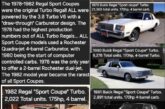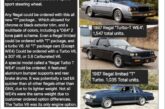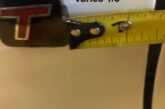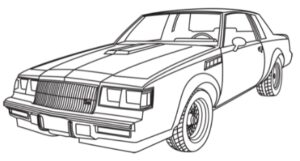.
So you finally upgraded your Turbo Buick and added on the ever popular Powerlogger unit.
You’ve been accustomed to using and tuning with the Scanmaster, but now you’ve got a new toy to use with your turbocharged V6 engine!
The Powerlogger for the turbo buick regal is data logging at its best!
But, of course, as with everything else new, there’s a learning curve to it.
Below is a crash course on what exactly all those symbols & readings on the Powerlogger mean, and what they represent when it comes to the information thats going on with your Buick Regal.
I got this info a while back, and don’t remember who wrote it, but wanted to share this, so kudos to them for these awesome explanations!
.
ECM AFR
This is what the ECM is commanding for air/fuel ratio.
Don’t pay too much attention to it, as sometimes we have to command weird numbers to get the ECM to do what we want.
MAF g/s
MAF reading in gr/sec.
Could be anywhere depending on boost and rpm.
Idle warmed up in park around 4-6 gr/sec, WOT 255 (for most chips), may read higher if using an Extender chip.
LV8 g/c
Load value that the ECM uses to decide what spark advance to use as well as many other things.
Could be anywhere from 0-255 depending on rpm and airflow.
TPS v
Throttle position voltage.
Keep it around .42-.44 throttle closed, and 4.4-4.6 wide open throttle (WOT).
RPM
Engine speed
EGR %
EGR (exhaust gas recirculation) duty cycle.
Could be anywhere depending on how the chip was programmed.
Some chips have EGR turned off.
Wastegate %
Wastegate solenoid duty cycle.
Could be anywhere depending on how the chip was programmed.
Speed mph
Vehicle speed
IAC cts
Position of the idle air motor in “counts” or “steps” from 00. 00 is closed.
At idle warmed up in park, keep it around 10-20.
If you have stalling problems, keep it closer to 00 in park.
In drive it will jump up higher.
This is adjusted using the “min air screw” on the throttle body.
To make the IAC number go lower, you would need to open the throttle blade more by turning the screw clockwise.
Prog Idle
This is the commanded idle speed programmed into the chip.
It will change with coolant temp and sometimes whether it’s in park or drive.
WB AFR
Air/Fuel ratio reading coming from a wideband O2 system if you connected one to your Powerlogger.
MAP kpa
Manifold absolute pressure reading coming from a MAP sensor if you connected one to your Powerlogger.
EGT DegF
Exhaust Temp reading if you connected an EGT sensor to your Powerlogger.
Psi4
Optional item connected to Powerlogger.
Psi5
Optional item connected to Powerlogger.
Coolant DegF
Coolant temp reading
Intake Air DegF
Air temperature reading coming from the IAT sensor (intake air).
Ign Volts v
ECM voltage reading that comes from the ignition switch.
It would be nice to keep this above 13.5v, but some cars drift down to around 13.0 at full throttle.
Boost Psi
Boost reading coming from a MAP sensor if you connected one to your Powerlogger.
(The stock setup does not have a boost input to the ECM.)
O2 v
Oxygen sensor voltage from the stock narrow band sensor.
When not in boost and in closed loop, this will jump up and down anywhere from 0 to 800.
When in boost, it usually stabilizes above 700 somewhere.
For pump gas we usually want somewhere in the 800 area, for race fuel a little leaner, maybe 750’s.
Varies from car to car and can be inaccurate at times.
A wideband O2 system is better.
X-Counts Cts
When in closed loop (not in boost), the O2 reading cycles up and down.
This counter keeps track of how many time the O2 reading crosses the midpoint (about .450mv).
It gives you an idea of the condition of the O2 sensor.
If you have a chip with open loop idle, this will not move much at idle.
There is no target number here, but if it’s climbing at least 20 numbers per second, it’s probably good.
Advance Deg
Spark advance programmed into the chip.
This does NOT include knock retard.
In other words if this shows 18*, and you also show 5* of knock retard, then you really only have 13* of advance.
Knock Retard Deg
Degrees of advance subtracted from commanded timing due to the ECM’s response to hearing knock.
Knock Counts cts
When the ECM hears knock, this counter climbs.
The longer the knock event, the faster the counter climbs.
Don’t pay much attention to this. Pay more attention to knock retard.
Injector Pw ms
The injectors are controlled by the ECM by pulsing them on and off.
This is the amount of time in milliseconds that the ECM commands the injector open.
No target number here, it could be all over depending on what the ECM is calculating.
Injector Duty %
There is only so much time between one cycle and the next for any given cylinder.
That amount of time can be calculated: 120000/RPM=max pw.
So at 5000rpm, the max pulsewidth is 24ms (120000/5000rpm).
You calc the duty cycle like this: actual pw / max pw.
So if the actual pw at 5000rpm is 15ms, then 15/24 = .63, or 63% duty cycle.
Duty cycle will change all over the place depending on the pw and rpm.
If the duty is 100% or higher, then the injectors are permanently ON and not pulsing anymore (said to be “static”).
This can happen at high rpm’s when a lot of fuel is needed.
Don’t be too concerned if the duty cycle is 100%, as long as the engine has enough fuel (good a/f ratio).
If it’s too lean, then you may need bigger injectors, or something is wrong in the fuel system.
Running 100% in itself does not hurt anything.
ALL stock GN’s ran that way from the factory at full throttle.
.


























